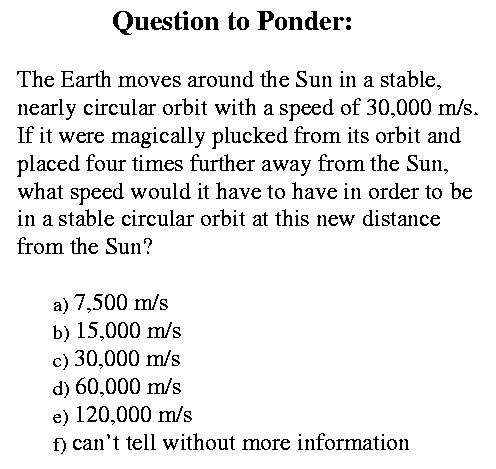|
Practice and thought might gradually forge many an art.
Virgil, Georgics I |
Assignments:Read Chapter 31, Section 5 (pp. 514-516)Chapter 32, Sections 1 and 2 (pp. 518-522) Chapter 32, Sections 8 and 9 (pp. 534-540) Note: When you finish this reading assignment, you should have completed reading all of Chapters 31 and 32, except Chapter 32, Section 7
Problem Set #5
|

In Class:
v = sqrt(GM/R)
- true for any object being pulled into a circular orbit
by a mass M that is located inside its orbit
- for the Solar system, the mass inside the orbit of every planet
is the same (ie, the mass of the Sun)
- so the M above is the same for all solar system orbits
What if the mass isn't the same in both cases?
- what if by moving the Earth farther from the Sun,
we move past other bits of mass
- then the mass the Earth feels pulling it in
when it's farther out
is greater than the mass it feels pulling it in
when it's close
- v = sqrt(GM/R)
- but now R is bigger, but so too is M
- the speed won't necessarily go down
- The Earth might has to move faster because the
pull of gravity is even stronger (because there's more
mass pulling on it)
We can turn this problem around and MEASURE the speed that the Earth
moves in the two locations.
Then we'll be able to figure out how much mass is interior to the Earth's
orbit at both locations
M_enc = v^2 R/G
this will tell us how much mass is within the first orbit
how much mass is within the second orbit
and with a little subtraction
how much mass is between the two orbits
by measuring the speed of lots of things at lots of different
distances, we can
we can map out the distribution of mass in the system
In our Solar system, this is pretty dull
- the amount of mass at all radii is essentially the same
because 99.99% of the mass in the solar system
is concentrated in the Sun
- rotation curve looks like speed is proportional to 1/srqt(R)
But for the galaxy, this isn't the case
- rotation curve does not decrease with distance
- in fact, it's rather "flat"
- as you go out to larger distances
the enclosed mass increases
--> that means not all of the galaxy's mass is at its
center
- if we plot the mass enclosed as a function of distance from the
center
- it increases almost linearly with distance from the center
---CALCULATION----
At our distance from the center of the Galaxy (about 8500 pc),
we (i.e., our solar system) move at a speed of about 220000 m/s
around the galactic center
M = v^2 R/ G
= (220,000 m/s)^2 (8500 x 3.09 x 10^16 m) / 6.67 x 10^-11 m^2/s^2 kg
= 1.9 x 10^41 kg, or 9.5 x 10^10 solar masses
about 100 billion solar masses
------------------
Puzzle: the rotation curve is flat out as far as we have measured
- ie., as we keep going outward in our gax, we keep
finding more mass.
- within the Sun's orbit, there's about 10^11 M_o of mass
- but from the rotation curve, there might be 10 times
more mass outside of our orbit
- after all of this work, we know where the center is, and
where we are relative to the center,
we know how much mass there is inside our orbit
- BUT we still don't know the total mass or size of the gax
- one annoying aspect is that the density of stars, gas, and dust
decreases quickly outside of our orbit, even if the mass doesn't
- we can find anything that glows, and count it up
- there isn't much glowing stuff further out in the galaxy
- however, the rotation curve says that there is mass out
there
-- that is, the motion of the bits we see out there
is too fast for the mass we can measure inside its
orbit
--> there must be more "unseen" mass
- so what is the mass out there made of?
- dunno
- often referred to as "dark matter" or "missing mass"
The "dark matter" problem is a real mystery of current interest
-- not just a problem for our galaxy
-- in most galaxies, rotation curves indicate the presence
of unseen matter, mostly in the outer parts of each galaxy
If for every galaxy, we're only seeing 10% of the mass that's there
then we're in the rather uncomfortable situation where
we might be missing 90% of the matter in the universe
- talk about embarrassing
- astronomy is supposed to be the study of the universe
and we have no idea what 90% of it is made of.
One possibility:
neutrinos
- remember those little products of the fusion process?
- whenever we changed a proton to a neutron or
a neutron to a proton, we made one
- they are the most abundant particle in the universe
- about 10^19 zipping through your fingertip right now
until recently, it was thought that neutrinos had zero mass
- like photons of light
- but new measurements (i.e., in the last year or less)
suggest that maybe that's not the case
- if neutrinos have mass
- even a tiny tiny tiny mass
- there are enough of them around to solve the
dark matter problem
we'll come back to the dark matter problem when we start discussing
the universe as a whole in a few weeks
|
![]()